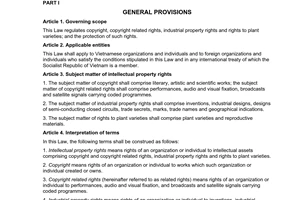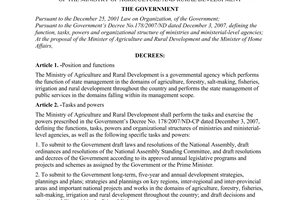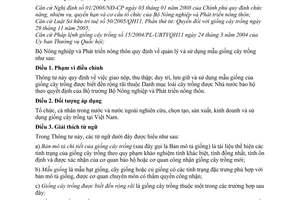Nội dung toàn văn Circular No 41/2009/TT-BNNPTNN of July 9, 2009, on management and use of specimens of plant varieties.
|
THE
MINISTRY OF AGRICULTURE AND RURAL DEVELOPMENT |
SOCIALIST
REPUBLIC OF VIETNAM Independence
- Freedom – Happiness |
|
No. 41/2009/TT-BNNPTNN |
Ha Noi, July 9, 2009 |
CIRCULAR
ON MANAGEMENT AND USE OF SPECIMENS OF PLANT VARIETIES
THE MINISTRY OF AGRICULTURE AND RURAL DEVELOPMENT
Pursuant to the Government's
Decree No. 01/2008/ND-CP of January 3, 2008, defining the functions, tasks,
powers and organizational structure of the Ministry of Agriculture and Rural
Development;
Pursuant to Intellectual Property Law No. 50/2005/QH11 of November 29, 2005,
Part Four: Rights to plant varieties;
Pursuant to National Assembly Standing
Committee's Plant Variety Ordinance No. 15/ 2004/PL-UBTVQH11 of March 24, 2004;
The Ministry of Agriculture and Rural Development prescribes the management and
use of plant variety specimens as follows:
Article 1. Scope of regulation
This Circular prescribes the delivery, collection, preservation, storage and use of specimens of popular plant varieties on the list of plant species under state protection according to the Ministry of Agriculture and Rural Development's decision.
Article 2. Subjects of application
This Circular applies to domestic and foreign organizations and individuals engaged in the study, selection, creation, production, trading and use of plant varieties in Vietnam.
Article 3. Interpretation of terms
In this Circular, the terms below are construed as follows:
a/ Written detailed description of a plant variety (below referred to as variety description) means a document representing properties of a agricultural plant variety under regulations on distinctness, uniformity and stability (DUS) testing, which is certified by a new plant variety protection or recognition agency;
b/ Variety specimen means the sample of a breeder seed, sapling or tuber with specific properties in conformity with its variety description recognized by a competent professional agency;
c/ Popular plant variety means a variety falling into one of the following cases:
- Plant varieties whose applications for recognition or protection have been accepted;
- Plant varieties which have been recognized to be added to the list of plant varieties permitted for production and trading or granted protection titles;
- Plant varieties other than those specified above which are produced and traded on the market, including local varieties.
Article 4. Delivery and collection of variety specimens
1. Variety specimens and variety specimen dossiers
Each popular plant variety has one specimen and a variety specimen dossier comprises a technical declaration on the plant variety specimen, made according to the form provided in Appendix 3 to this Circular (not printed herein), and a variety description under regulations on DUS testing for each plant species. Variety specimens and their dossiers shall be delivered or collected and stored under this Circular.
2. Delivery of seed specimens
a/ The following owners of popular asexual reproductive plant varieties shall submit a variety specimen dossier and one seed specimen to seed specimen storing agencies (below referred to as storing agencies) specified in Appendix 1 to this Circular (not printed herein):
- Organizations and individuals registering for plant variety recognition;
- Organizations and individuals registering for plant variety protection;
- Organizations and individuals with recognized plant varieties;
- Organizations and individuals with plant varieties which are granted protection titles or that are transferred or inherited plant variety protection titles from other organizations and individuals;
- Organizations and individuals other than those specified above having plant varieties which are produced and traded.
b/ Storing agencies shall concurrently act as agencies to conduct DUS testing for plant varieties.
c/ The time for delivering seed specimens, technical declarations and variety descriptions (if any) is prescribed as follows:
- For plant varieties registered for recognition: before the recognition of plant varieties for trial production;
- For plant varieties registered for protection: at least 20 days before the sowing of plant varieties for DUS testing;
- For plant varieties other than those specified above: before the production of and trading in new varieties.
d/ Seed specimens and their dossiers may be delivered to storing agencies directly or by post. Storing agencies may receive variety specimens and seed specimen dossiers at offices of organizations and individuals having varieties to be stored.
Storing agencies shall make a written record of delivery of seed specimens according to the form provided in Appendix 4 to this Circular (not printed herein). A copy of this record shall be kept in variety recognition dossiers or new variety protection dossiers.
e/ The minimum quantity of seed specimens to be stored complies with Appendix 2 to this Circular (not printed herein). The quality of seed specimens must at least reach that of certified varieties or equivalent.
f/ Organizations and individuals having parental varieties shall store and supply their specimens to storing agencies upon written request.
3. Collection of seed specimens
a/ Storing agencies shall collect, and compile dossiers of, specimens of local varieties and varieties under production and trading whose owners or creators are unknown.
b/ Organizations and individuals which are storing, studying, producing and trading in plant varieties specified at Point a of this Clause shall coordinate with storing agencies in collecting variety specimens and compiling their dossiers.
4. Specimens of breeder saplings and tubers
Organizations and individuals specified at
Point a. Clause 2 of this Article that have popular asexual reproductive plant varieties shall store specimens of breeder saplings and tubers and compile their dossiers to meet their use requirements without having to deliver variety specimens to storing agencies.
Article 5. Preservation and storage of variety specimens
1. Preservation and storage of seed specimens
a/ Evaluation of seed specimens:
- Within 20 days after receiving a seed specimen, a storing agency shall examine its qualitative indicators against current standards. If its quality fails, the agency shall collect or request the variety owner to deliver a new seed specimen. Within 30 days after receiving the storing agency's notice, the variety owner shall deliver a new seed specimen to the storing agency.
- For plant varieties registered for protection: Seed specimens which are concurrently samples for DUS testing shall be sowed by storing agencies according to regulations on DUS testing to evaluate their distinctness, uniformity and stability.
- In other cases, when necessary, storing agencies may sow seed specimens to evaluate their distinctness, uniformity and stability. If finding any disconformities of seed specimens, storing agencies shall request variety owners to supply other specimens.
b/ Preservation of seed specimens: Within the validity duration of new plant variety protection titles or when plant varieties remain in production and trading, storing agencies shall:
- Preserve seed specimens under the conditions which can retain the seeds' germinability and germination rates;
- Regularly check the seeds' germinability and germination rates. If the quality of seed specimens fails, collect or request variety owners to additionally deliver new seed specimens, except the varieties reproduced by storing agencies under Point c of this Clause.
- Sow additional new seed specimens to compare with old specimens (if any) and variety descriptions; if there is a difference, collect, or request the delivery of, other specimens.
c/ In the course of preservation, storing agencies may reproduce seed specimens of pure varieties to meet their needs for preservation and use, provided that the quality of reproduced varieties must conform with standards and variety descriptions.
d/ After evaluating seed specimens, storing agencies shall transfer a quantity of seed specimens (except cross-bred varieties) in accordance with Appendix 2 to this Circular (not printed herein), copies of technical declarations and variety descriptions (if any) to the Plant Resources Center for long-term storage of seed specimens as a national gene source.
e/ When a storing agency makes a written request, the Plant Resources Center shall coordinate with the former in preserving collected seed specimens; expenses for specimen preservation shall be agreed by the two parties under contracts.
f/ Owners of popular plant varieties shall preserve these varieties according to their variety descriptions for production and business; and deliver them to storing agencies and meet other use demands under Article 6 of this Circular.
When the validity duration of a protection title expires or a plant variety is no longer produced and traded, they shall notify such in writing to storing agencies for decision on continued storage or cancellation of that seed specimen.
2. Preservation and storage of specimens of breeder saplings and tubers
a/ Owners of asexual reproductive plant varieties shall preserve and store specimens of their breeder saplings (prototypal saplings or gardens of prototypal saplings) or breeder tubers in conformity with standards and compile their dossiers to meet production, business and use requirements under Article 6 of this Circular.
b/ Owners of plant varieties shall report on locations to store specimens of breeder saplings and tubers to the Cultivation Department (New Plant Variety Protection Office) when submitting protection registration applications or to Agriculture and Rural Development Departments of localities where plant varieties are recognized or produced and traded; provincial-level Agriculture and Rural Development Departments shall make a sum-up report to the Ministry (the Cultivation Department).
Article 6. Use of variety specimens
1. Specimens of agricultural plant varieties shall be used as follows:
a/ Being comparative, similar and typical varieties in DUS testing;
b/ Being standard samples in inspection, testing and post-recognition inspection of plant varieties;
c/ Being standard samples in inspection, examination and settlement of disputes over plant varieties;
d/ Being hereditary gene resources to be preserved and stored.
2. Organizations and individuals that need to use variety specimens shall make a written request to storing agencies or variety owners for supply and shall pay charges according to state regulations or under agreement if state regulations are unavailable.
3. Storing agencies, the Plant Resources
Center and variety specimen users may not infringe upon intellectual property rights of owners of specimens of plant varieties under law.
Article 7. Organization of implementation
1. This Circular takes effect 45 days from the date of its signing.
2. To request, by the end of December 31, 2009:
a/ Owners of popular plant varieties that have not delivered variety specimens to storing agencies to deliver them and their dossiers to storing agencies or report on locations to store specimens of breeder saplings and tubers to provincial-level Agriculture and Rural Development Departments under this Circular.
b/ Seed specimen storing agencies to examine and make a list of plant varieties whose specimens have not been stored or whose specimens fail to meet requirements; and request owners of varieties to deliver, or collect, variety specimens under this Circular.
c/ Provincial-level Agriculture and Rural Development Departments to examine and make a list of locations to store specimens of breeder saplings and tubers of asexual reproductive plant varieties in their localities for reporting to the Cultivation Department.
3. The director of the Cultivation Department, the chief of the Ministry Office, heads of the Ministry's attached units, and concerned organizations and individuals shall implement this Circular.
4. Any problems arising in the course of implementation should be reported in writing to the Ministry of Agriculture and Rural Development for prompt settlement.
|
|
FOR
THE MINISTER OF |



